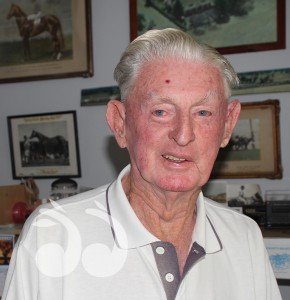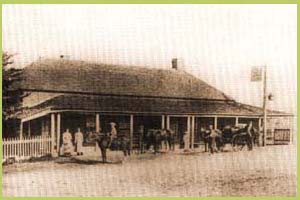Beginning of Racing in Scone
By Harley Walden
The breeding of horses began with the birth of the colony, it was not long before thoroughbreds arrived and organised racing began.
Breeding was mostly confined to the County of Cumberland and to the Hawkesbury and Nepean districts around Windsor and Richmond.
Yet, in time, these areas were considered inferior to the “new country” in the immense watershed od the Hunter Valley. Soon the spreading Paterson, Pages, Goulbourn, Widden and Bylong districts grew to outstrip all other areas to become one of the finest breeding nurseries in Australia.
It would be right to assume that the first horse to arrive in the Sone area would have been in the party headed by Francis Little, the first white man to live in the Scone district, when he took a grant of 30,000 acres, dated 15th July 1823, named Invermein.
Once settled, the number of Invermein horses increased, despite the loss of several good ones to marauding bushranges, and, by November 1827 here were twelve horses there – the third largest number on any Upper Hunter property.
The Littles’ neighbour, John Bingle of Puen Buen, had no horses in his stables at the time as he was only in the process of moving from Parramatta, William Dangar had two horses at Turnaville, the Hall brothers at Dartbrook had one each, and Donald Macintryre, newly arrived at Kuyuga, also had one.
The largest number of thoroughbreds in the Upper Hunter was at Segenhoe. They were followed by the Cox family estate of Negoa, near Muswellbrook, both of which had more than twenty horses. There were perhaps a hundred horses in the whole of the Upper Hunter by 1828.
Race meetings began to arise in all parts of the State, although racing in this area around 1830 was confined mainly to a few of the major settlements including Maitland and the Patrick Plains.
Scone Race Club – one of the most represented clubs in country racing – has undergone many alterations over the years. It has seen many committee members rise and pass, had its share of some of the most respected men associated with racing and breeding in the club, and seen the best of country racing and thoroughbred horse sales. It has raced on six different racecourses since holding its first race meeting in 1842.
The first race meetings held in Scone during the 1840s were held on a section of Oxford Road, between Kelly Street and the Hospital. According to old identities this was the first setting for Scone’s early race meetings.
The Parish Map of Scone shows the original 620 acre grant, proclaimed by William Dumaresq, upon which the Village and, later, the Municipality of Scone was built. The Racecourse Paddock was located on the eastern boundary of the township. At this time the eastern boundary of Scone was Main Street and the land beyond was regarded as Bakewell’s Paddock or the Old Racecourse Paddock.
This property enclosed the town on the north, east, and south and the area from Gundy Road north past Murray Bain Oval and east towards the Hospital.
This land, now part of the residential township of Scone, was used continuously during the period 1842-1892 for race meetings.
It is recorded that the mile course had its stat in Oxford Road, from where the field ran in the direction of Gundy road, turned and came in a westerly direction to Park Street, ran along the street and swung towards what were the golf links to the present site of the Scott Memorial Hospital. It was finished in close proximity to an unpretentious grandstand, a steward’s stand and booth.
There was no outside running rail, as evident by the actions of inexperienced maiden horses. Merton Maid and Binnalong ran off the course at the 1862 meeting.
The main improvements to the course were completed in the late 1880s; the straight had been fenced off, new marking posts placed around the course and improvements made to the jockey’s room. Prior to each meeting the course was run over several times with a set of harrows.
The first recorded race meeting followed a similar format to those that had been well established in the lower Hunter.
The logistics involved in establishing horse racing in Scone were not undertaken by the landed gentry, as had been the case with the establishment of the Sydney Turf Club. The landlord of The White Swan, Mr J.P.Wilkie too full responsibility.
This experience involved a considerable outlay of capital in supplying prizes. The main prize was a horse and cart valued at 45 pounds and a percussion gun at 20 pounds.
From the Federation Publication No 2 published by the Scone and Upper Hunter Historical Society 1998 titled The Inn, The Dentist and The School, by Mac Bain, Roger Humphries and Gillian Blandford Hayes, Mace Bain writes of the early days relating to the Inn.
From this we can glean an insight into J.P.Wilkie: “On 14 February 1842 the first public transport began to travel from Scone. It was a coach put on the road by John Wilkie and the fare to Singleton was one pound.”
He must have been very keen on horses and racing, as in January 1842 the Sydney Morning Herald reported that the first Scone Races were held in that month and, although run for hacks and got up solely by the “mine host” of the White Swan, J.P.Wilkie as the “New Year Sports” there was very excellent running.
J.P.Wilkie left Scone around 1843. It was recorded that his wife, Grace Marshall Wilkie died 29 September 1843, at Murrurundi aged 24 years, ten days after giving birth to a son. She had also come to Australia from St Columb, Cornwall.
John Wilkie went on to be an Innkeeper in Murrurundi taking the name of The White Swan with him.
By the late 1840s racing had become a well-organised and well-patronised recreational activity in the town. Interest in the sport enabled a three-day meeting to be held on the 26th, 27th, 28th of December, 1848.
The above article is an excerpt from Harley Walden’s book The Spirit Within – Scone’s Racing History, Published by Hunter Valley Printing, 2004, p.1-3.
 scone.com.au
scone.com.au
